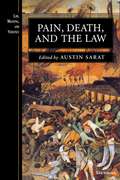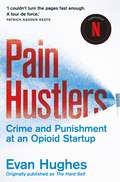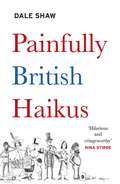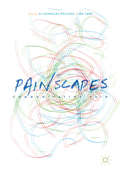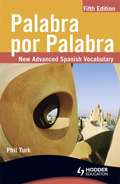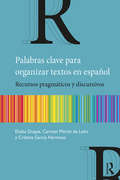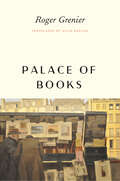- Table View
- List View
The Pages
by Hugo Hamilton‘A rich, strange book. Very truthful and moving’ Tessa Hadley 'A terrific, engrossing novel’ Roddy Doyle ‘A masterpiece’ Sebastian Barry The new novel about the transformative power of art, the weight of history and the strange connection we make with one another from the author of The Speckled People.
Pah-La (Oberon Modern Plays)
by Abhishek Majumdar“I just lit up. I did not burn” In a remote Tibetan village, Deshar, a young runaway has disowned her father Tsering and become a Buddhist nun. In Lhasa, Chinese Commander Deng is working for the future of the country, unable to meet the needs of his wife and daughter. When Deshar carries out an act of defiance it reverberates across the whole country and a new freedom struggle is born with life-changing consequences for Deshar, Deng and their families. “Tell that girl, she has changed Tibet forever.” Pah-la, based on real stories during the 2008 Lhasa riots, is an examination of the future of non-violence.
Pain and the Aesthetics of US Literary Realism
by Cynthia J. DavisThe postbellum period saw many privileged Americans pursuing a civilized ideal premised on insulation from pain. Medico-scientific advances in anesthetics and analgesics and emergent religious sects like Christian Science made pain avoidance seem newly possible. The upper classes could increasingly afford to distance themselves from the suffering they claimed to feel more exquisitely than did their supposedly less refined contemporaries and antecedents. The five US literary realists examined in this study resisted this contemporary revulsion from pain without going so far as to join those who celebrated suffering for its invigorating effects. William Dean Howells, Henry James, Edith Wharton, Mark Twain, and Charles Chesnutt embraced the concept of a heightened sensitivity to pain as a consequence of the civilizing process but departed from their peers by delineating alternative definitions of a superior sensibility indebted to suffering. Although the treatment of pain in other influential nineteenth century literary modes including sentimentalism and naturalism has attracted ample scholarly attention, this book offers the first sustained analysis of pain's importance to US literary realism as practiced by five of its most influential proponents.
Pain and the Aesthetics of US Literary Realism
by Cynthia J. DavisThe postbellum period saw many privileged Americans pursuing a civilized ideal premised on insulation from pain. Medico-scientific advances in anesthetics and analgesics and emergent religious sects like Christian Science made pain avoidance seem newly possible. The upper classes could increasingly afford to distance themselves from the suffering they claimed to feel more exquisitely than did their supposedly less refined contemporaries and antecedents. The five US literary realists examined in this study resisted this contemporary revulsion from pain without going so far as to join those who celebrated suffering for its invigorating effects. William Dean Howells, Henry James, Edith Wharton, Mark Twain, and Charles Chesnutt embraced the concept of a heightened sensitivity to pain as a consequence of the civilizing process but departed from their peers by delineating alternative definitions of a superior sensibility indebted to suffering. Although the treatment of pain in other influential nineteenth century literary modes including sentimentalism and naturalism has attracted ample scholarly attention, this book offers the first sustained analysis of pain's importance to US literary realism as practiced by five of its most influential proponents.
Pain, Death, and the Law (Law, Meaning, And Violence)
by Austin SaratThis collection of essays examines the relationship between pain, death, and the law and addresses the question of how the law constructs pain and death as jurisprudential facts. The empirical focus of these essays enables the reader to delve into both the history and the theoretical complexities of the pain-death-law relationship. The combination of the theoretical and the empirical broadens the contribution this volume will undoubtedly make to debates in which the right to live or die is the core issue at hand. This volume will be an important read for policy makers and legal practitioners and a valuable text for courses in law, the social sciences, and the humanities. Austin Sarat is William Nelson Cromwell Professor of Jurisprudence and Political Science, Amherst College.
Pain Hustlers: Now a major Netflix film
by Evan HughesNow a major film streaming on NETFLIX‘I couldn’t turn the pages fast enough. A tour de force.’ – Patrick Radden Keefe, award-winning author of Empire of Pain'Everyone should read this book' - Sheelagh Kolhatkar, author of Black EdgeJohn Kapoor had already made a small fortune in pharmaceuticals when he developed a highly potent fentanyl-based painkiller that was as addictive as it was effective. Desperate to make the most of his new drug, he brought together an ambitious, persuasive and relentless group of young recruits who were willing to do anything to profit from this seemingly life-chanigng medicine.This is the inside story of hustlers turned millionaires and a shocking exposé of how opioids entered the national bloodstream.'A fast-paced and maddening account' - The New York Times Book ReviewPreviously published as The Hard Sell
Painful pleasures: Sadomasochism in medieval cultures (Manchester Medieval Literature and Culture)
by David Matthews Anke Bernau Christopher Vaccaro James PazThis timely volume ventures into the subject of sadomasochism in varied aspects of medieval life. Saint’s Lives and mystical treatises provide evidence of failed sadism and empowering masochism. Literary culture in the form of epics and courtly tales preserve stories of eroticised power. These exciting chapters join together to form a picture of medieval culture that is kinky in its practice and deeply psychological at its core.
Painful pleasures: Sadomasochism in medieval cultures (Manchester Medieval Literature and Culture)
by Christopher VaccaroThis timely volume ventures into the subject of sadomasochism in varied aspects of medieval life. Saint’s Lives and mystical treatises provide evidence of failed sadism and empowering masochism. Literary culture in the form of epics and courtly tales preserve stories of eroticised power. These exciting chapters join together to form a picture of medieval culture that is kinky in its practice and deeply psychological at its core.
Painfully British Haikus
by Dale ShawThis Christmas give them,The PERFECT stocking filler, Sure to make them laugh. The Sellotape endUnlocatable it seemsChristmas is cancelledHow many gin tinsIs decreed appropriate For this train journey? The sound of a splashMy Hobnob falls to piecesMy tea is sulliedEvery houseplantSuffers a slow painful deathI am a monsterYou're at the seasideA seagull eyes your MagnumYou won't win that fightEnjoy this hilarious collection of over 200 haikus that sum up the complex, confusing and often compounding character of the British people - a great stocking filler or secret santa gift!
Pains and Gains of Ethnic Multilingual Learners in China: An Ethnographic Case Study (Multilingual Education #17)
by Ge WangThis book introduces an ethnographic case study of two English majors of ethnic minority at YUN, a local university of nationalities in southwest China. Drawing on the theories of post-structuralism and critical multiculturalism, this book mainly studies two female multilingual individuals in Yunnan, China. By scrutinizing university policies, curriculum, personal learning histories, and by discussing the unequal power relationship between national policies, school curricula, and ethnic multilingual learners,this book provides information at a micro-level on how the two ethnic minority students, who have acquired three languages (L1-native, L2-Mandarin Chinese, and L3-English), successfully navigate the Chinese higher education system as multilingual learners despite various tensions, difficulties, and challenges. How these students construct their multiple identities as well as significant factors affecting such identity construction is also discussed. This book will contribute to the scholarship of policy and practice in ethnic multilingual education in China by addressing the challenges for tertiary institutions and ethnic multilingual learners. The author also points out that multiculturalism as a discourse of education might help ease the tension of being an ethnic minority and a Chinese national, and reduce the danger of being assimilated or being marginalized.
Painscapes: Communicating Pain
by Ej Gonzalez-Polledo Jen TarrThis book brings into dialogue approaches from anthropology, sociology, visual art, theatre, and literature to question what kinds of relations, frames and politics constitute pain across disciplines and methodologies. Each chapter offers a unique window onto the notoriously difficult problem of how pain is defined and communicated. The contributors reimagine the value of images and photography, poetry, history, drama, stories and interviews, not as ‘better’ representations of the pain experience, but as devices to navigate the complexity of pain across different physical, social, and intersubjective domains. This innovative collection provides a new access point to the phenomenon of pain and the materialities, affects, structures and institutions that constitute it. This book will appeal to readers seeking to better understand pain’s complexity and the social and affective ecologies through which pain is known, communicated and lived.
The Painter: The Night Season; Shoreditch Madonna; Her Naked Skin; The Painter
by Rebecca LenkiewiczThe fashionables, they tell me their artistic opinion. They just want to know if a painting is hot. Whether it will gain. And then they criticise anyone who is different, anyone who's not on the 'direct route' to taste. Fuck 'em.Turner, the English romantic landscape artist and 'painter of light', was a man obsessed. Intensely prolific he was heavily reliant on his father, deeply affected by his mother's rejections and isolated from the usual breed of artists.English painting is dead. It's dealers making fortunes out of sentimental dross. Dogs. Cherubs.The Painter by Rebecca Lenkiewicz premiered at the Arcola Theatre, London, in January 2011 in the production which marked the opening of its new premises on Ashton Street.
Painting the Novel: Pictorial Discourse in Eighteenth-Century English Fiction (British Literature in Context in the Long Eighteenth Century)
by Jakub LipskiPainting the Novel: Pictorial Discourse in Eighteenth-Century English Fiction focuses on the interrelationship between eighteenth-century theories of the novel and the art of painting – a subject which has not yet been undertaken in a book-length study. This volume argues that throughout the century novelists from Daniel Defoe to Ann Radcliffe referred to the visual arts, recalling specific names or artworks, but also artistic styles and conventions, in an attempt to define the generic constitution of their fictions. In this, the novelists took part in the discussion of the sister arts, not only by pointing to the affinities between them but also, more importantly, by recognising their potential to inform one another; in other words, they expressed a conviction that the theory of a new genre can be successfully rendered through meta-pictorial analogies. By tracing the uses of painting in eighteenth-century novelistic discourse, this book sheds new light on the history of the so-called "rise of the novel".
Painting the Novel: Pictorial Discourse in Eighteenth-Century English Fiction (British Literature in Context in the Long Eighteenth Century)
by Jakub LipskiPainting the Novel: Pictorial Discourse in Eighteenth-Century English Fiction focuses on the interrelationship between eighteenth-century theories of the novel and the art of painting – a subject which has not yet been undertaken in a book-length study. This volume argues that throughout the century novelists from Daniel Defoe to Ann Radcliffe referred to the visual arts, recalling specific names or artworks, but also artistic styles and conventions, in an attempt to define the generic constitution of their fictions. In this, the novelists took part in the discussion of the sister arts, not only by pointing to the affinities between them but also, more importantly, by recognising their potential to inform one another; in other words, they expressed a conviction that the theory of a new genre can be successfully rendered through meta-pictorial analogies. By tracing the uses of painting in eighteenth-century novelistic discourse, this book sheds new light on the history of the so-called "rise of the novel".
Painting Women: Cosmetics, Canvases, and Early Modern Culture
by Patricia PhillippyThis original analysis of the representation and self-representation of women in literature and visual arts revolves around multiple early modern senses of "painting": the creation of visual art in the form of paint on canvas and the use of cosmetics to paint women's bodies. Situating her study in sixteenth- and seventeenth-century Italy, France, and England, Patricia Phillippy brings together three distinct actors: women who paint themselves with cosmetics, women who paint on canvas, and women and men who paint women—either with pigment or with words. Phillippy asserts that early modern attitudes toward painting, cosmetics, and poetry emerge from and respond to a common cultural history. Materially, she connects those who created images of women with pigment to those who applied cosmetics to their own bodies through similar mediums, tools, techniques, and exposure to toxic materials. Discursively, she illuminates historical and social issues such as gender and morality with the nexus of painting, painted women, and women painters.Teasing out the intricate relationships between these activities as carried out by women and their visual and literary representation by women and by men, Phillippy aims to reveal the delineation and transgression of women's creative roles, both artistic and biological. In Painting Women, Phillippy provides a cross-disciplinary study of women as objects and agents of painting.
Pakistani Englishes: Syntactic Variations
by Asma IqbalThis book explores how non-native speakers, especially in postcolonial states, use English to communicate. Focusing on Pakistan, the monograph analyzes word categories, phrase and sentence structures used in the region and compares them to British English. It draws extensively from language used in the media and uses Lexical Functional Grammar (LFG) parsers to develop the phrase structures for qualitative analysis and a manual approach to quantify the frequency of various types of phrases. The volume also highlights the possible reasons for the differences and locates language use in context. The volume will be of great interest to researchers, scholars, and teachers interested in linguistics, especially sociolinguistics, postcolonial studies, critical theory, media studies and World Englishes.
Pakistani Englishes: Syntactic Variations
by Asma IqbalThis book explores how non-native speakers, especially in postcolonial states, use English to communicate. Focusing on Pakistan, the monograph analyzes word categories, phrase and sentence structures used in the region and compares them to British English. It draws extensively from language used in the media and uses Lexical Functional Grammar (LFG) parsers to develop the phrase structures for qualitative analysis and a manual approach to quantify the frequency of various types of phrases. The volume also highlights the possible reasons for the differences and locates language use in context. The volume will be of great interest to researchers, scholars, and teachers interested in linguistics, especially sociolinguistics, postcolonial studies, critical theory, media studies and World Englishes.
Palabra Por Palabra: New Advanced Spanish Vocabulary (PDF)
by Phil Turk5th edition (fifth). Help your students achieve their best on the exams with authentic and sophisticated phrases. This new edition of the bestselling A Level Spanish vocabulary reference book provides idiomatic phrases drawn from real sources such as newspapers, magazines and websites to ensure the most accurate and authentic language. - Covers key vocabulary in thematic sections and with distinctions between levels of difficulty from AS to A2 - Easy for students to reference and search ahead of exams with topics matched to latest exam specifications - Ensure students know the latest phrases and idioms with new entries for the latest development in communications and technology - Increase students' repertoire with lists of synonyms - Have the latest information at their fingertips with updated lists of current web addresses More vocabulary lessons available online at Vocab Express, an interactive learning application. Visit www. vocabexpress. co. uk/hodder for more information.
Palabra Por Palabra Sixth Edition: Spanish Vocabulary For Aqa A-level
by Phil Turk Mike ThackerSpanish Vocabulary For Aqa A-level
Palabras clave para organizar textos en español: Recursos pragmáticos y discursivos
by Eladio Duque Carmen Martín de León Cristina Garcia HermosoPalabras clave para organizar textos en español: recursos pragmáticos y discursivos está dirigido a estudiantes de español como lengua extranjera –de nivel B2/ C1 (MCER) o Intermediate High/ Advanced Low (ACTFL)– que deseen mejorar la coherencia de sus textos hablados y escritos. En este libro el lector encontrará explicaciones teóricas acompañadas de numerosas actividades en las que pondrá en práctica una gran variedad de estructuras, estrategias y herramientas útiles para conectar frases y párrafos de manera eficaz.Palabras clave para organizar textos en español se fundamenta en el uso de la lengua en contextos de comunicación real. El libro puede utilizarse de manera independiente o como material de clase, ya que, además de las actividades con las que el aprendiz puede autoevaluar su progreso, también incluye actividades abiertas y juegos para trabajar en grupo.
Palabras clave para organizar textos en español: Recursos pragmáticos y discursivos
by Eladio Duque Carmen Martín de León Cristina Garcia HermosoPalabras clave para organizar textos en español: recursos pragmáticos y discursivos está dirigido a estudiantes de español como lengua extranjera –de nivel B2/ C1 (MCER) o Intermediate High/ Advanced Low (ACTFL)– que deseen mejorar la coherencia de sus textos hablados y escritos. En este libro el lector encontrará explicaciones teóricas acompañadas de numerosas actividades en las que pondrá en práctica una gran variedad de estructuras, estrategias y herramientas útiles para conectar frases y párrafos de manera eficaz.Palabras clave para organizar textos en español se fundamenta en el uso de la lengua en contextos de comunicación real. El libro puede utilizarse de manera independiente o como material de clase, ya que, además de las actividades con las que el aprendiz puede autoevaluar su progreso, también incluye actividades abiertas y juegos para trabajar en grupo.
Palace of Books
by Roger GrenierFor decades, French writer, editor, and publisher Roger Grenier has been enticing readers with compact, erudite books that draw elegant connections between the art of living and the work of art. Under Grenier’s wry gaze, clichés crumble, and offbeat anecdotes build to powerful insights. With Palace of Books, he invites us to explore the domain of literature, its sweeping vistas and hidden recesses. Engaging such fundamental questions as why people feel the need to write, or what is involved in putting one’s self on the page, or how a writer knows she’s written her last sentence, Grenier marshals apposite passages from his favorite writers: Chekhov, Baudelaire, Proust, James, Kafka, Mansfield and many others. Those writers mingle companionably with tales from Grenier’s half-century as an editor and friend to countless legendary figures, including Albert Camus, Romain Gary, Milan Kundera, and Brassai,. Grenier offers here a series of observations and quotations that feel as spontaneous as good conversation, yet carry the lasting insights of a lifetime of reading and thinking. Palace of Books is rich with pleasures and surprises, the perfect accompaniment to old literary favorites, and the perfect introduction to new ones.
Palace of Books
by Roger GrenierFor decades, French writer, editor, and publisher Roger Grenier has been enticing readers with compact, erudite books that draw elegant connections between the art of living and the work of art. Under Grenier’s wry gaze, clichés crumble, and offbeat anecdotes build to powerful insights. With Palace of Books, he invites us to explore the domain of literature, its sweeping vistas and hidden recesses. Engaging such fundamental questions as why people feel the need to write, or what is involved in putting one’s self on the page, or how a writer knows she’s written her last sentence, Grenier marshals apposite passages from his favorite writers: Chekhov, Baudelaire, Proust, James, Kafka, Mansfield and many others. Those writers mingle companionably with tales from Grenier’s half-century as an editor and friend to countless legendary figures, including Albert Camus, Romain Gary, Milan Kundera, and Brassai,. Grenier offers here a series of observations and quotations that feel as spontaneous as good conversation, yet carry the lasting insights of a lifetime of reading and thinking. Palace of Books is rich with pleasures and surprises, the perfect accompaniment to old literary favorites, and the perfect introduction to new ones.
Palace of Books
by Roger GrenierFor decades, French writer, editor, and publisher Roger Grenier has been enticing readers with compact, erudite books that draw elegant connections between the art of living and the work of art. Under Grenier’s wry gaze, clichés crumble, and offbeat anecdotes build to powerful insights. With Palace of Books, he invites us to explore the domain of literature, its sweeping vistas and hidden recesses. Engaging such fundamental questions as why people feel the need to write, or what is involved in putting one’s self on the page, or how a writer knows she’s written her last sentence, Grenier marshals apposite passages from his favorite writers: Chekhov, Baudelaire, Proust, James, Kafka, Mansfield and many others. Those writers mingle companionably with tales from Grenier’s half-century as an editor and friend to countless legendary figures, including Albert Camus, Romain Gary, Milan Kundera, and Brassai,. Grenier offers here a series of observations and quotations that feel as spontaneous as good conversation, yet carry the lasting insights of a lifetime of reading and thinking. Palace of Books is rich with pleasures and surprises, the perfect accompaniment to old literary favorites, and the perfect introduction to new ones.
Palace of Books
by Roger GrenierFor decades, French writer, editor, and publisher Roger Grenier has been enticing readers with compact, erudite books that draw elegant connections between the art of living and the work of art. Under Grenier’s wry gaze, clichés crumble, and offbeat anecdotes build to powerful insights. With Palace of Books, he invites us to explore the domain of literature, its sweeping vistas and hidden recesses. Engaging such fundamental questions as why people feel the need to write, or what is involved in putting one’s self on the page, or how a writer knows she’s written her last sentence, Grenier marshals apposite passages from his favorite writers: Chekhov, Baudelaire, Proust, James, Kafka, Mansfield and many others. Those writers mingle companionably with tales from Grenier’s half-century as an editor and friend to countless legendary figures, including Albert Camus, Romain Gary, Milan Kundera, and Brassai,. Grenier offers here a series of observations and quotations that feel as spontaneous as good conversation, yet carry the lasting insights of a lifetime of reading and thinking. Palace of Books is rich with pleasures and surprises, the perfect accompaniment to old literary favorites, and the perfect introduction to new ones.



